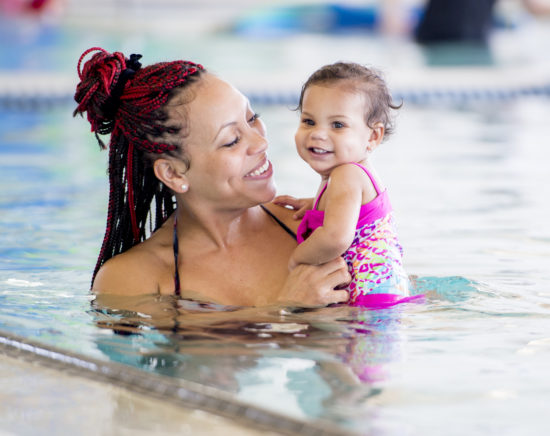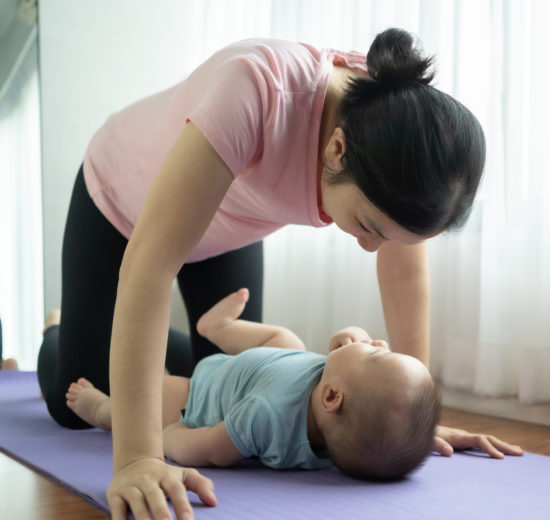If you’re keen to get back to your fitness routine but are not sure how safe it is, here’s what you need to know…
As soon as you feel up to it, it’s safe to go for walks and do pelvic floor exercises and gentle stretches. Don’t worry if you can’t quite manage those pelvic floors just yet. You’ll know as soon as you’ve healed enough when to give them a go.
Pelvic floor exercises help to strengthen the muscles of the pelvic floor. These muscles come under massive strain during pregnancy and when you give birth.
You’ll soon be doing them on the bus, in a meeting or while queuing for a coffee.
If your pelvic floor muscles are weak, a bit of wee might sneak out when you cough, sneeze or strain. This is known as stress incontinence, and – you may have discovered during a natter with your mum mates – it’s super common following childbirth.
To get your pelvic floor muscles strong again, exercise them lying down, sitting or standing. After a while, you’ll be able to do these exercises anywhere. You’ll soon be doing them on the bus, in a meeting or while waiting in the queue for a coffee.
For more information on how to start practising pelvic floor exercises, click here.
The two abdominal muscles (rectus abdominis) that run down the middle of the abdomen often separate during pregnancy. How much they separate varies between women.
These muscles separate because of your growing womb pushing them apart. This makes your abdominal muscles longer and weaker.
Here’s how to check the size of your separation, after you’ve had your baby:
Generally, to get back to proper, high-impact exercise like running or your much-loved zumba class, it’s best to wait until your six-week postnatal check-up.

It will also depend what type of birth you had. For example, if you had a caesarean section, your recovery time might be longer. It might also depend on how much exercise you did before you were pregnant.
Certain types of exercise might be better if you have weak pelvic floor muscles too. If you’ve got any doubts or questions about whether the exercise you’re doing is ok, talk to your midwife, health visitor or GP.
But generally, don’t be too nervous about it – it’s great to get back to exercise after having a baby. There are loads of reasons to exercise, including your mental and physical health. So go for it and have fun.
Swimming is great exercise. It’s low-impact and good for some chill-out time for you too. You’ll need to wait until seven days after your postnatal bleeding (lochia) has stopped to hop (or maybe step tentatively) into the pool.

Some postnatal classes let you do the exercise class with your baby at your side, which isn’t as ridiculous as it sounds. Especially with a newborn who’ll often snooze through the whole thing.
Some even include your baby and their pram or buggy as part of the workout. Plus they’re often outdoors in local parks, which is a nice bonus.
If you’re going to a class that isn’t a special postnatal class, make sure you tell the instructor that you’ve recently had a baby.
Your ligaments and joints are much more supple in the months after you give birth, so just be aware of that. It’s easier than before pregnancy for new mums to injure themselves by stretching or twisting too much.
Your body produced relaxin in pregnancy to make your ligaments more elastic
You’re more likely to get injured because of a group of hormones called relaxin. Your body produced relaxin in early pregnancy to make the ligaments in the body more elastic.
The downside of relaxin is that it can cause back problems and injuries. Plus its impact on the joints might linger around for up to five months after you have your baby.
If you’re in pain or your postnatal bleeding (lochia) gets heavier or changes colour (becomes pink or red) after activity, you might be doing too much.
If you’re struggling for time to dedicate to specific postnatal exercise, there’s still a lot you can do. Try the following:
NCT’s helpline offers practical and emotional support in all areas of pregnancy, birth and early parenthood: 0300 330 0700.
You might find attending one of NCT’s Early Days groups helpful as they give you the opportunity to explore different approaches to important parenting issues with a qualified group leader and other new parents in your area.
Make friends with other parents-to-be and new parents in your local area for support and friendship by seeing what NCT activities are happening nearby.